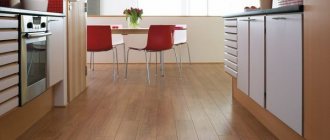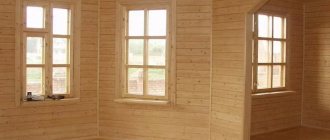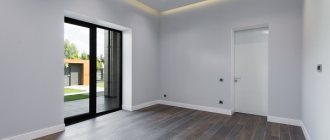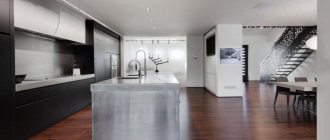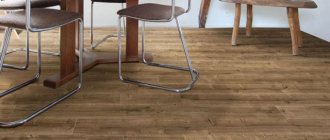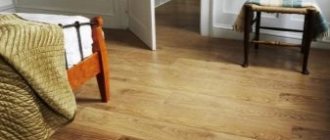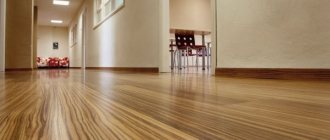Before laying a floating floor, knowledgeable customers periodically ask me whether it is necessary to lay film under the laminate. Here we can clarify that the film is placed under the substrate.
The technical instructions contained in the package with laminated parquet indicate: “To ensure warranty service, it is necessary to lay a vapor barrier with a thickness of 0.2 mm or 200 microns.”
Let's try to figure out why moisture-proof polyethylene is needed and how well it works. In Leroy
Edit 2022
I must note. In the last year of observations, the PVC vapor barrier film under the laminate has a strong unpleasant odor. Which completely negates the idea of using it with materials such as parquet boards or cork. Positioned by sellers as the pinnacle of environmental cleanliness.
The second point, which I had not previously mentioned, is that the spread film forms air pockets due to the folds. And when you further lay the backing on top of the film, the backing does not completely adhere to the base. Sounds may occur after laminate flooring is installed. Of course, the air will subsequently escape and the laminate will settle down. But I had to give extra explanations.
Before a long story, I want to notify readers that most types of laminate have their own protection from moisture penetration underneath. It consists of a bottom layer consisting of melamine resin or kraft paper, which is moisture-resistant, and covers more than 99% of the surface of the plank. The chance of panel joints getting into a substrate seam tends to zero, and the possible contact area of unprotected parts is 0.0000...
Is film needed for laminate flooring?
In some cases it is necessary to place the film under the laminate:
- The foundation of the room is not sufficiently insulated from ground and atmospheric moisture; it can absorb it from the air and ground.
- The premises initially experience increased humidity due to the geographical location of the building or the characteristics of the room (basement, bathroom, kitchen).
- The floor has a concrete base or a self-leveling mixture has been used.
The last factor is the most common, since laminate can only be laid on flat floors. Therefore, in most cases, a concrete or self-leveling screed is first installed.
Important! The use of insulation can be avoided if the laminate is laid on a wooden base or plywood, on linoleum, or if a specialized underlay is used that already has waterproofing protection.
How thick should the substrate be?
There is an opinion that the thicker the substrate under the laminate, the better it will be. You can even meet people who lay it in several layers to achieve maximum insulation and sound insulation. There is a significant disadvantage with this approach, which is that such a substrate under point loads (any heavy object or even a person) can be strongly compressed, causing the laminate boards to even break.
With a substrate thickness of 3 mm or more, the connections of the lamellas may deform over time, since the laminate is not adapted to regular bending when walking. From such a load, the locks quickly wear out, as a result of which cracks appear and the floor begins to creak heavily. Therefore, it is important to consider the rigidity of the substrate and its thickness. The smoother the base, the thinner the material can be laid.
Why lay film under laminate?
The need to use a vapor barrier film for flooring under laminate is due to the fact that this decorative material is made of wood fiber raw materials. All installation instructions contain instructions for additional protection of the floors from moisture from below.
Moisture not only destroys the material and can cause it to warp, but also contributes to the spread of mold and unpleasant odors. To prevent this from happening, a film should be placed when installing the laminate.
If the panels swell due to moisture, the manufacturer has the right to cancel the warranty because proper lower water protection was not provided
Recommendations and tips
When leveling a floor under a laminate using wood boards, the waterproofing film should be laid under this underlayment, and not on top. Moisture protection should be under the leveling layer of plywood or chipboard, but not on top of them.
How to install different types of waterproofing
Do not replace waterproofing with foam underlayment. The second is laid for sound insulation and to prevent creaking of laminate slats. It is not able to replace plastic film. Moreover, according to the rules, the soundproofing substrate must be laid end-to-end, and not overlapping. It is impossible to achieve the necessary insulation from condensation here.
How to properly install insulation
If the screed is less than six months old, then laminate flooring must not be laid on it without waterproofing. The full cycle of moisture release from concrete takes more than three weeks. Here, either wait at least a month, or spread plastic wrap. But if the laminate flooring is installed on top of old parquet, then, on the contrary, the moisture-proofing substrate should be abandoned. It is absolutely not needed here.
How to properly apply waterproofing and underlayment
Types of films for laminate flooring on concrete floors
The most common types of material are:
- traditional polyethylene;
- reinforced film;
- membrane.
Polyethylene is the most common type of protection, which is an excellent heat insulator. There is a version with and without perforation. It is characterized by resistance to moisture, and the absence of organic and natural substances protects the lower surface of the flooring from pests. The disadvantages of polyethylene options include the ability to sag, the “greenhouse effect” (temperature may rise under the floor), as well as fragility - it is easy to damage during installation.
Reinforced film is a two-layer polymer material, supplemented between the layers with a reinforcing mesh, which gives strength and rigidity. Reinforcement guarantees maximum vapor permeability and resistance to mechanical stress - even with rigid installation, the material is difficult to tear.
Membranes are a whole class of non-woven fabrics, primarily made of polypropylene. They are characterized by a high breaking load, are not afraid of temperature changes, and are characterized by the best vapor barrier, preserving the natural microclimate of the room. And if laying the laminate with film and backing is for some reason impossible, use a membrane, since it alone replaces 2 materials.
Disadvantages of natural substrates
Despite the expanded list of positive qualities, natural materials have some disadvantages:
- High price. Compared to artificial analogues, the difference can reach 40 percent or more.
- Sensitivity to changes in the concrete base. Cork and coniferous substrates for laminate “tolerate” a difference of no more than 2 mm for every 2 meters of cement screed. Otherwise, the laid laminate will constantly sag and, as a result, its locks will diverge, which will create an unpresentable appearance. So if you decide to use a natural substrate under a laminate flooring, take care to carefully level the concrete base.
Laminate substrates created on the basis of artificial polymer compounds are much cheaper than their natural counterparts. The most popular and accessible are:
- made of foamed polypropylene;
- from expanded polystyrene;
- foil backing;
- “Tuplex” backing.
The most common material for the manufacture of inexpensive substrates is a polypropylene compound. The term “inexpensive” in no way means poor quality. This material absorbs laminate flooring quite well under load. Satisfactorily absorbs extraneous noise and retains heat.
The backing has a wavy structure that allows air to ventilate freely under the laminate. It is not afraid of condensation or moisture, and is produced in strips up to 5 mm thick, rolled into rolls. The main advantage of synthetic materials is their stability with differences (irregularities) of up to 4 mm per two meters. The main disadvantage of this material is that it does not withstand large static loads, under which air bubbles can burst, resulting in a change in its thickness.
Polystyrene foam backing
The substrate is made from polystyrene foam molded under certain conditions. This material is much stronger and denser than foamed polypropylene. Its peculiarity is that it is able to withstand heavy loads for a long time. It is produced in the form of plates or mats of gray-green color.
Extruded polystyrene foam has no environmental contraindications for use in residential and work areas. It can smooth out minor unevenness in the underlying concrete floor. This type of substrate is in great demand in the construction market.
However, polypropylene substrates have certain disadvantages. This material has a structure similar to foam bubbles. Over time, under load, the pores burst and become compressed. When a laminate coating is used intensively, the substrate loses its shape and elasticity, which negatively affects its protective properties. Another drawback is that it is a fairly flammable material through which fire spreads quickly.
But, despite these disadvantages, polypropylene backing remains a leader in a specific market segment because it is the most satisfactory and budget option.
Foil backing
It is usually made on the basis of polypropylene, and can be covered with foil on one or both sides. It costs more, but its thermal insulation properties are much higher than those of a substrate made of ordinary polypropylene.
Any type of underlay must be laid joint-to-joint under the laminate. The edges of the strips are tightly fixed to each other with tape. For the foil backing, mirror tape is used on the floor side to create the effect of a thermos as fully as possible. This will reduce heat loss much more effectively, and the bubbles in polypropylene will additionally provide sound insulation!
Remember that the total thickness of the laminate and underlay should not exceed the jointed floor coverings of adjacent rooms.
“Tuplex” backing
Tuplex underlayment is a 3 mm thick composite material consisting of two layers of polyethylene film and a layer of granular polystyrene foam in between. The pores in polystyrene foam and the air between the granules reliably retain heat and also protect against extraneous noise and sounds. This type of underlay can even be laid on a screed that has little residual moisture.
The high-strength top layer of polyethylene can withstand significant loads, but its main task is to prevent moisture from passing through and to protect the laminate, preventing it from deforming. The bottom layer of polyethylene, on the contrary, has a porous structure that allows moisture to pass into the polystyrene foam layer, through which the moisture escapes outside around the perimeter of the room.
How to lay film under laminate
In order for the waterproofing film under the laminate to fit tightly to the base and not create air pockets, it is important that it is installed correctly. The floor must first be cleaned, dried and leveled. Then insulating material is laid on it over the entire area of the room, from wall to wall, with an overlap of 20 cm. To ensure high-quality vapor barrier, it must also extend onto the walls (at least 5 cm).
The film is fixed with construction tape (ordinary adhesive tape can be used). A backing is placed on top.
The direction of laying the laminate and film should be perpendicular
Popular materials for waterproofing
You can install the laminate, observing the manufacturer’s requirements for waterproofing the screed, using two methods:
- use a substrate with a moisture-proof layer;
- waterproof the screed with specialized materials.
Substrate as a waterproofing layer
In the trade you can find 3 types of substrates that effectively protect the laminate from moisture without installing waterproofing:
- expanded polystyrene (trademark "Penoplex");
- polyethylene foam;
- bitumen-cork substrates (trade mark "TUPLEX").
Extruded polystyrene foam not only performs well as a shock absorber during floor operation, but also does not allow moisture to pass from the screed to the lamellas.
The big disadvantage is the high cost. Price 1 m2 - 165-180 rubles.
Polyethylene foam is the most popular material for laminate backing. The advantages include:
- holds heat well;
- does not allow water to pass through (100% insulation of the floor covering from condensate evaporation is achieved);
- resistant to microorganisms and rodents;
- low price.
This material also has serious disadvantages:
- releases harmful substances into the surrounding space;
- sags quickly during operation;
- accumulates static voltage.
The average price of 1 m2 is 14 rubles.
Attention: when laying polystyrene foam and polyethylene foam, the joints must be glued together with tape, and the material itself is placed 3-4 cm on the wall along the entire perimeter. After installing the floor, the protruding edges of the substrate are carefully trimmed, then covered with a plinth.
Bitumen cork is made from kraft paper impregnated with bitumen, on which a layer of cork chips is applied on top. Bitumen retains moisture well. However, complete sealing of the laminate from moisture from below is impossible. The junction of the wall and the substrate interferes. The problem is solved by additional waterproofing the places where the cork comes into contact with the wall.
There is one minus, but an important one. Very high price. Therefore, it is used only when laying expensive laminate flooring (the average price of 1 m 2 with a thickness of 30 mm is 250 rubles).
When choosing a specific type of material for the substrate, it is necessary to take into account all of the listed factors.
Waterproofing materials
On the building materials market you can find a wide variety of waterproofing materials. This:
- various mastics;
- emulsions;
- dry waterproofing mixtures;
- rolled materials represented by various films, roofing felt, roofing felt.
However, to insulate floor slats from condensation, you can only use roll insulation. Why? The presence of a damper tape does not allow completely isolating the contact of the floor with the evaporation of condensate moisture using mastics, emulsions or special dry mixtures.
Always near the walls, evaporation from the surface of the screed, when waterproofing with such materials, will enter the laminate. The desired effect can only be achieved with film.
Important: roll waterproofing materials also include various types of roofing felt and roofing felt. They have a very high level of insulation from moisture. However, they cannot be used as a waterproofing material directly on a floor screed under a laminate. The reason is their thickness. There is no way to do without a backing when laying them, and together with the backing you get a very thick layer between the floor and the screed. Under dynamic loads, the oscillatory movements of laminate panels will be higher than those provided by its manufacturer. The result is broken lamella locks and early replacement of the floor.
Film waterproofing materials are made from various polymers:
- polyethylene;
- polyvinyl chloride;
- polypropylene;
- synthetic rubber.
Video
Polyethylene films used for steam and waterproofing are considered to be an auxiliary material when laying floors and should be used only as desired. In this matter, it is worth assessing the possible consequences of not using films under the laminate - damage to the entire floor covering from fumes from the concrete or cement base. And take into account the low cost of films relative to other components of the floor covering.
With careful work and a responsible approach, the film will not cause any damage, but will only add peace of mind to the insulation and preserve the owner’s guarantee for a reliable laminated coating.
Laminate has long taken its place among the most popular building materials. With its help, you can quickly and relatively cheaply create a practical and aesthetically attractive floor covering. Laminated panels can so accurately imitate the texture of expensive and rare wood species that it is almost impossible to recognize it visually. But this material requires preparation of the base before installation. This is especially true for rooms where the humidity level is high. Waterproofing under laminate is a requirement of all suppliers and manufacturers of this flooring. Failure to comply with this condition may result in loss of product warranty. High humidity can cause the material to warp. How to prevent such troubles and avoid damage to the laminate from moisture is in the following paragraphs, but first you should talk about its structure: this will help in choosing the optimal method of protection.
This flooring is assembled from individual panels up to 140 cm long and about 20 cm wide. The thickness can vary: from 6 to 12 mm. Along the edges of each element there are grooves and tenons for connecting them. This is a multilayer material, the top layer of which is a special protective film made of melamine or acrylic resin, which has high abrasion resistance. It also prevents the ingress of dust and moisture, and protects from sunlight.
The next layer is decorative: most often it is paper treated in a special way, the coloring of which gives the laminate its appearance. If the top layer is damaged and moisture penetrates, it may become unusable.
Next is the main layer, which is made from fiberboard or chipboard using high pressure under high temperature conditions. Despite its high density and resistance to moisture, this layer is the weakest point of the laminate: if the waterproofing is not of sufficient quality, moisture penetrates into the structure of the material from the end connection, which leads to swelling and deformation of the floor covering.
The bottom layer is paper impregnated with a special resin. It is responsible for the stability of the shape of each element and protects against moisture. But the capabilities of this material are limited and require additional preparation of the base before laying the laminate. This is important both for panels that are connected to each other using glue, and for material with a locking connection.
The weak point of the laminate is the supporting base
Do not disturb the structure
Every residential building has mechanisms that prevent water penetration. But even when these systems are in excellent condition, they do not make the building completely waterproof. Rather, they help make the building resistant to water penetration. But many residents of apartment buildings deliberately destroy these constructive solutions. For example, in standard series of panel houses there are special cabins inside the bathroom. Residents destroy the walls of such a cabin, gaining a few centimeters of space, while exposing themselves and their neighbors below to the risk of flooding.
It is important to understand that concrete floors themselves are in no way waterproof. Ordinary concrete behaves like a dense sponge. One cubic meter of good quality dry concrete will absorb approximately 60 liters of water in just 30 minutes!
| material type | Hygroscopic absorption | Water absorption |
| heavy concrete | 7,8% | 4,8% |
| lightweight concrete | 20,2% | 10,2% |
| cellular concrete | 25% | 15,5% |
Therefore, concrete needs a waterproof membrane over it in wet areas of the apartment, such as toilets, bathrooms and kitchens, to prevent water from entering it. Common materials used for interior waterproof membranes include a combination of tiles, waterproof grout, waterproof screeds, epoxy paints, and waterproof plastic sheeting.
The most common cause of wet spots on the ceiling is a violation of the integrity of the waterproof membrane or the lack of waterproofing in the floor screed in an apartment on the top floor. Failure may be caused by normal wear and tear of the waterproof membrane, damage to the material, or improper design or installation of the membrane. The membrane loses its waterproof properties and is no longer able to prevent water from penetrating the porous concrete floor slab and leaking into the apartment below.
To repair a waterproof membrane, all tiles, fixtures and anything else that could interfere with the repair work must be removed. If the area contains a bathroom, you may need to remove the shower stall and toilet. That is why it is important to think about waterproofing the concrete floor in an apartment at the initial renovation stage.
Then it is necessary to apply a layer of waterproof membrane and screed to the entire surface of the floor. It is very important to raise the waterproofing from the floor to the walls, around pipes and over the base of any doorway. Only after the waterproofing of the wall floors has been carried out in accordance with the manufacturer's specifications should the finishing coating be started.
Rules for applying rubber paint "AKTERM HydroStop"
Before applying mastic, it is important to make sure that the surface is dry, not prone to capillary rise of moisture, and has no traces of paint coatings, oils, grease and other substances that impede the quality adhesion of the waterproofing coating to the base.
Rubber paint must be applied at a temperature of no less than +7 °C and no more than +45 °C, the layer thickness should not exceed 1 mm, the consumption in this case is 1.15 kg per square meter. The drying time of the applied layer is 24-48 hours at t>+15°C, after which it is possible to apply the next layer of waterproofing crosswise in relation to the previous one.
The optimal thickness of the waterproofing layer is 2 mm. A correctly applied waterproofing layer is uniform, dense, without sagging. After the mastic has dried, you can install the heated floor, if planned, and lay the finishing floor covering.

